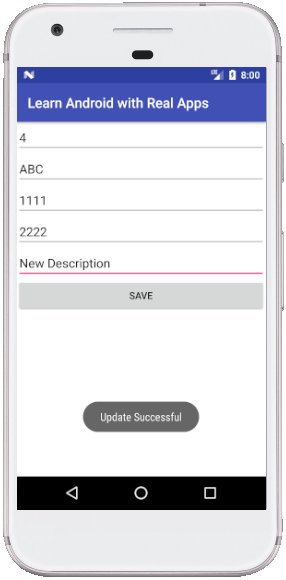Create Spring Boot Project
On the Eclipse, create a Spring Boot project
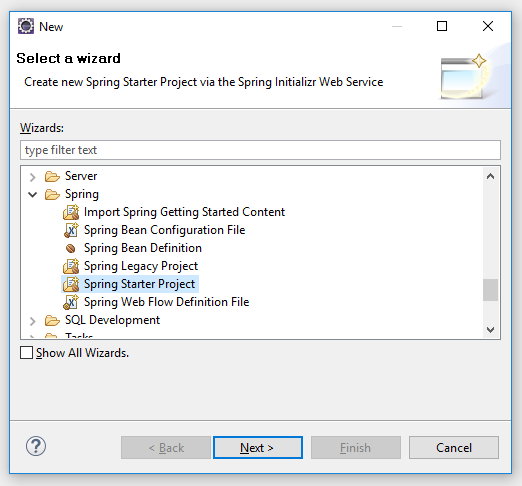
Enter Project Information:
- Name: WebAPIServer
- Group: com.demo
- Artifact: WebAPIServer
- Description: Web API Server
- Package: com.demo
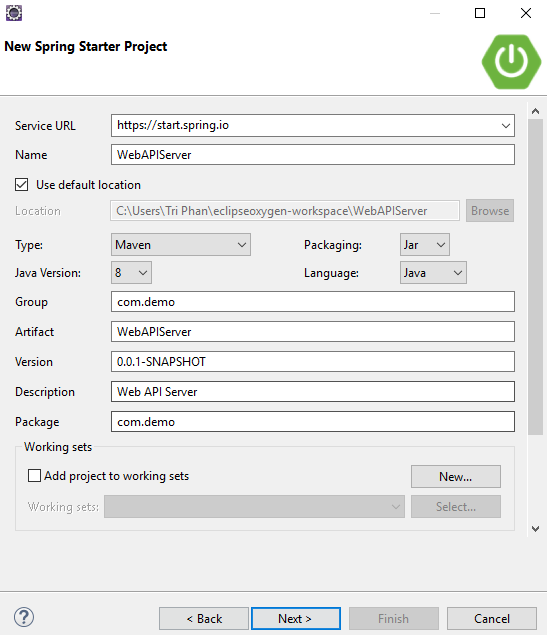
Select the technologies and libraries to be used:
- JPA
- MySQL
- Web
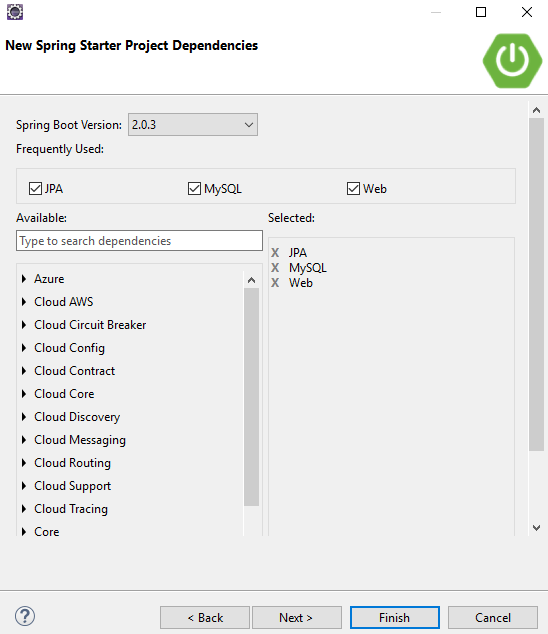
Click Next button to show Site Information for project

Click Finish button to finish create Spring Boot project
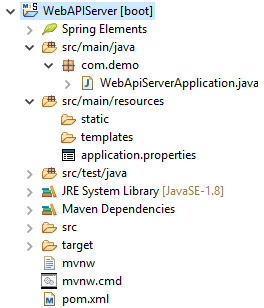
Configure pom.xml
<?xml version="1.0" encoding="UTF-8"?>
<project xmlns="http://maven.apache.org/POM/4.0.0"
xmlns:xsi="http://www.w3.org/2001/XMLSchema-instance"
xsi:schemaLocation="http://maven.apache.org/POM/4.0.0 http://maven.apache.org/xsd/maven-4.0.0.xsd">
<modelVersion>4.0.0</modelVersion>
<groupId>com.demo</groupId>
<artifactId>WebAPIServer</artifactId>
<version>0.0.1-SNAPSHOT</version>
<packaging>jar</packaging>
<name>WebAPIServer</name>
<description>Web API Server</description>
<parent>
<groupId>org.springframework.boot</groupId>
<artifactId>spring-boot-starter-parent</artifactId>
<version>2.0.3.RELEASE</version>
<relativePath /> <!-- lookup parent from repository -->
</parent>
<properties>
<project.build.sourceEncoding>UTF-8</project.build.sourceEncoding>
<project.reporting.outputEncoding>UTF-8</project.reporting.outputEncoding>
<java.version>1.8</java.version>
</properties>
<dependencies>
<dependency>
<groupId>org.springframework.boot</groupId>
<artifactId>spring-boot-starter-data-jpa</artifactId>
</dependency>
<dependency>
<groupId>org.springframework.boot</groupId>
<artifactId>spring-boot-starter-web</artifactId>
</dependency>
<dependency>
<groupId>mysql</groupId>
<artifactId>mysql-connector-java</artifactId>
<scope>runtime</scope>
</dependency>
<dependency>
<groupId>org.springframework.boot</groupId>
<artifactId>spring-boot-starter-test</artifactId>
<scope>test</scope>
</dependency>
</dependencies>
<build>
<plugins>
<plugin>
<groupId>org.springframework.boot</groupId>
<artifactId>spring-boot-maven-plugin</artifactId>
</plugin>
</plugins>
</build>
</project>
Create Database
Create a database with the name is web_api_server. This database have 1 table: Product table
--
-- Table structure for table `product`
--
CREATE TABLE `product` (
`id` int(11) NOT NULL PRIMARY KEY AUTO_INCREMENT,
`name` varchar(250) NOT NULL,
`price` double NOT NULL,
`quantity` int(11) NOT NULL,
`description` text NOT NULL
) ENGINE=InnoDB DEFAULT CHARSET=utf8 COLLATE=utf8_unicode_ci;
--
-- Dumping data for table `product`
--
INSERT INTO `product` (`id`, `name`, `price`, `quantity`, `description`) VALUES
(1, 'Computer 1', 14, 2, 'Description 1'),
(2, 'Computer 2', 5, 7, 'Description 2'),
(3, 'Mobile 1', 7, 4, 'Description 3'),
(4, 'Mobile 2', 11, 8, 'Description 4'),
(5, 'Mobile 3', 7, 9, 'Description 5');
Structure of Product Table

Data of Product Table
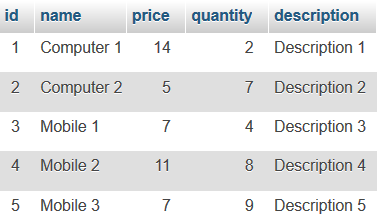
Configure application.properties
spring.datasource.url= jdbc:mysql://localhost:3306/web_api_server
spring.datasource.username=root
spring.datasource.password=123456
server.port=9596
Entities Class
Create new package named com.demo.entities. In this package, create a entity class – Product.java, to represent the above table
Product Entity
package com.demo.entities;
import java.io.Serializable;
import javax.persistence.Entity;
import javax.persistence.GeneratedValue;
import javax.persistence.GenerationType;
import javax.persistence.Id;
import javax.persistence.Table;
@Entity
@Table(name = "product")
public class Product implements Serializable {
@Id
@GeneratedValue(strategy = GenerationType.IDENTITY)
private int id;
private String name;
private double price;
private int quantity;
private String description;
public int getId() {
return id;
}
public void setId(int id) {
this.id = id;
}
public String getName() {
return name;
}
public void setName(String name) {
this.name = name;
}
public double getPrice() {
return price;
}
public void setPrice(double price) {
this.price = price;
}
public int getQuantity() {
return quantity;
}
public void setQuantity(int quantity) {
this.quantity = quantity;
}
public String getDescription() {
return description;
}
public void setDescription(String description) {
this.description = description;
}
}
Create ProductRepository Interface
Create new package named com.demo.repositories. In this package create the ProductRepository interface implements from CrudRepository interface of Spring Data JPA that provides CRUD operations for an entity.
package com.demo.repositories;
import org.springframework.data.repository.CrudRepository;
import org.springframework.stereotype.Repository;
import com.demo.entities.Product;
@Repository("productRepository")
public interface ProductRepository extends CrudRepository<Product, Integer> {
}
Create ProductService Interface
The ProductService.java interface contains methods to interact with the database.
package com.demo.services;
import com.demo.entities.Product;
public interface ProductService {
public Product save(Product product);
}
Create ProductServiceImpl class
The ProductServiceImpl.java class implements methods from ProductService.java interfaces that contains methods to interact with the database.
package com.demo.services;
import org.springframework.beans.factory.annotation.Autowired;
import org.springframework.stereotype.Service;
import com.demo.entities.Product;
import com.demo.repositories.ProductRepository;
@Service("productService")
public class ProductServiceImpl implements ProductService {
@Autowired
private ProductRepository productRepository;
@Override
public Product save(Product product) {
return productRepository.save(product);
}
}
Create Rest API Controller
Create new package named com.demo.controllers. In this package, create controller as below:
ProductController
Create new java class, named ProductController.java
package com.demo.controllers;
import org.springframework.beans.factory.annotation.Autowired;
import org.springframework.http.HttpStatus;
import org.springframework.http.ResponseEntity;
import org.springframework.util.MimeTypeUtils;
import org.springframework.web.bind.annotation.RequestBody;
import org.springframework.web.bind.annotation.RequestMapping;
import org.springframework.web.bind.annotation.RequestMethod;
import org.springframework.web.bind.annotation.RestController;
import com.demo.entities.Product;
import com.demo.services.ProductService;
@RestController
@RequestMapping("api/product")
public class ProductController {
@Autowired
private ProductService productService;
@RequestMapping(value = "save",
method = RequestMethod.PUT,
produces = { MimeTypeUtils.APPLICATION_JSON_VALUE },
headers = "Accept=application/json")
public ResponseEntity<Product> save(@RequestBody Product product) {
try {
return new ResponseEntity<Product>(productService.save(product), HttpStatus.OK);
} catch (Exception e) {
return new ResponseEntity<Product>(HttpStatus.BAD_REQUEST);
}
}
}
Structure of Spring Boot Project
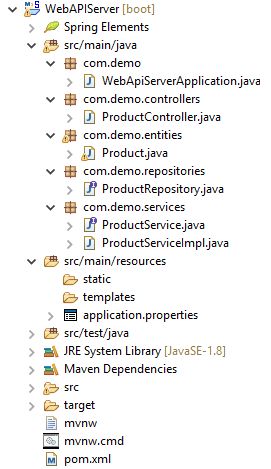
Create Android Project
Create new project in Android Studio with steps as below:
Step 1: Input Project Name and Select Project Location
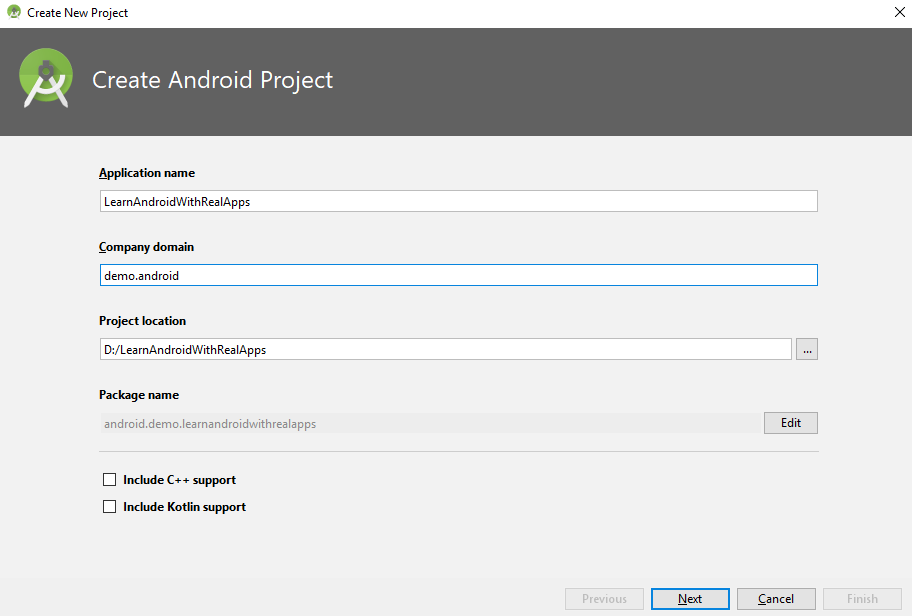
Step 2: Select SDK for Android App
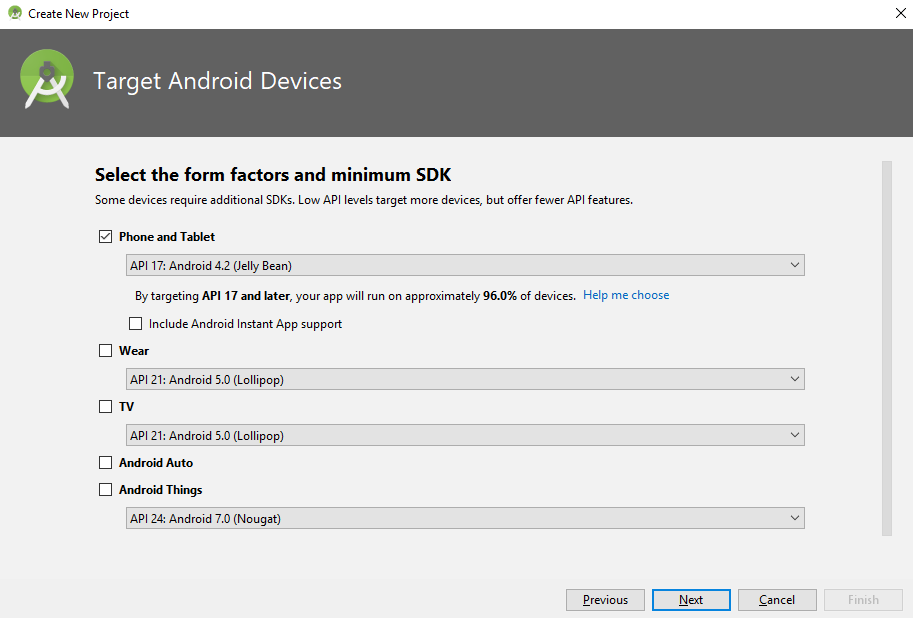
Step 3: Select Default Activity for App
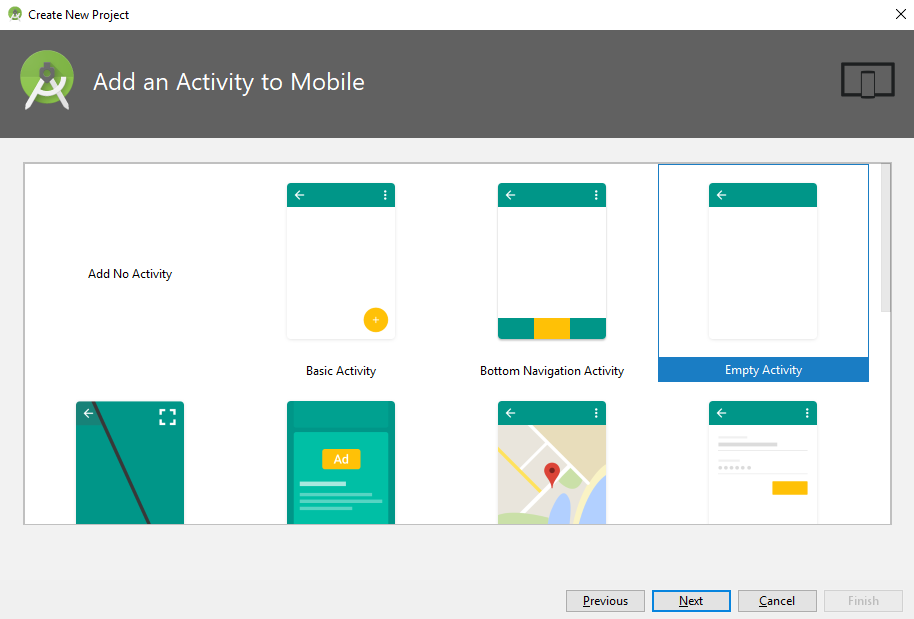
Step 4: Finish create project
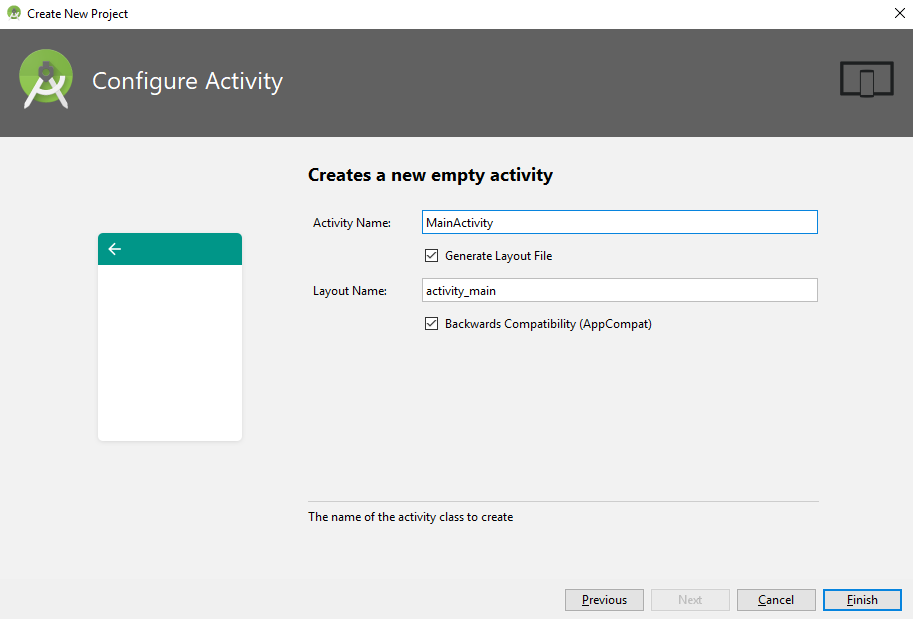
Add Strings
Open res\values\strings.xml file and add new string as below:
<resources>
<string name="app_name">Learn Android with Real Apps</string>
<string name="usd">$</string>
<string name="id">Id</string>
<string name="name">Name</string>
<string name="price">Price</string>
<string name="quantity">Quantity</string>
<string name="description">Description</string>
<string name="save">Save</string>
<string name="update_successful">Update Successful </string>
</resources>
Add Library as Dependencies
Open build.gradle file in Gradle Scripts and add Retrofit libraies as below:
implementation 'com.squareup.retrofit2:retrofit:2.3.0'
implementation 'com.google.code.gson:gson:2.6.2'
implementation 'com.squareup.retrofit2:converter-gson:2.1.0'
implementation 'com.squareup.okhttp3:logging-interceptor:3.4.1'
implementation 'com.squareup.okhttp3:okhttp:3.4.1'
Manifest Permissions
Open AndroidManifest.xml file in manifest folder, add permissions as below:
<?xml version="1.0" encoding="utf-8"?>
<manifest xmlns:android="http://schemas.android.com/apk/res/android"
package="android.demo.learnandroidwithrealapps">
<uses-permission android:name="android.permission.INTERNET" />
<application
android:allowBackup="true"
android:icon="@mipmap/ic_launcher"
android:label="@string/app_name"
android:roundIcon="@mipmap/ic_launcher_round"
android:supportsRtl="true"
android:theme="@style/AppTheme">
<activity android:name=".MainActivity">
<intent-filter>
<action android:name="android.intent.action.MAIN" />
<category android:name="android.intent.category.LAUNCHER" />
</intent-filter>
</activity>
</application>
</manifest>
Create Entities
Create new package named entities. In this package, create new java class named Product.java as below:
package android.demo.entities;
import com.google.gson.annotations.SerializedName;
import java.io.Serializable;
public class Product implements Serializable {
@SerializedName("id")
private int id;
@SerializedName("name")
private String name;
@SerializedName("price")
private double price;
@SerializedName("quantity")
private int quantity;
@SerializedName("description")
private String description;
public int getId() {
return id;
}
public void setId(int id) {
this.id = id;
}
public String getName() {
return name;
}
public void setName(String name) {
this.name = name;
}
public double getPrice() {
return price;
}
public void setPrice(double price) {
this.price = price;
}
public int getQuantity() {
return quantity;
}
public void setQuantity(int quantity) {
this.quantity = quantity;
}
public String getDescription() {
return this.description;
}
public void setDescription(String description) {
this.description = description;
}
}
Retrofit API
Create new package named api. In this package, create new api as below:
APIClient
Create new java class named APIClient.java as below:
package android.demo.services;
import okhttp3.OkHttpClient;
import okhttp3.logging.HttpLoggingInterceptor;
import retrofit2.Retrofit;
import retrofit2.converter.gson.GsonConverterFactory;
public class APIClient {
private static Retrofit retrofit = null;
public static Retrofit getClient() {
HttpLoggingInterceptor interceptor = new HttpLoggingInterceptor();
interceptor.setLevel(HttpLoggingInterceptor.Level.BODY);
OkHttpClient client = new OkHttpClient.Builder().addInterceptor(interceptor).build();
retrofit = new Retrofit.Builder()
.baseUrl("http://192.168.0.102:9596/api/")
.addConverterFactory(GsonConverterFactory.create())
.client(client)
.build();
return retrofit;
}
}
Product API
Create new interface named ProductAPI.java as below:
package android.demo.api;
import android.demo.entities.Product;
import retrofit2.Call;
import retrofit2.http.Body;
import retrofit2.http.POST;
public interface ProductAPI {
@PUT("product/save")
Call<Product> save(@Body Product product);
}
Main Activity Layout
Open res\layout\activity_main.xml file and create layout as below:
<?xml version="1.0" encoding="utf-8"?>
<LinearLayout xmlns:android="http://schemas.android.com/apk/res/android"
xmlns:tools="http://schemas.android.com/tools"
android:layout_width="fill_parent"
android:layout_height="fill_parent"
android:background="#ffffff"
android:orientation="vertical"
tools:ignore="HardcodedText">
<EditText
android:id="@+id/editTextId"
android:layout_width="match_parent"
android:layout_height="wrap_content"
android:ems="10"
android:hint="@string/id"
android:inputType="textPersonName" />
<EditText
android:id="@+id/editTextName"
android:layout_width="match_parent"
android:layout_height="wrap_content"
android:ems="10"
android:hint="@string/name"
android:inputType="textPersonName" />
<EditText
android:id="@+id/editTextQuantity"
android:layout_width="match_parent"
android:layout_height="wrap_content"
android:ems="10"
android:hint="@string/quantity"
android:inputType="textPersonName" />
<EditText
android:id="@+id/editTextPrice"
android:layout_width="match_parent"
android:layout_height="wrap_content"
android:ems="10"
android:hint="@string/price"
android:inputType="textPersonName" />
<EditText
android:id="@+id/editTextDescription"
android:layout_width="match_parent"
android:layout_height="wrap_content"
android:ems="10"
android:hint="@string/description"
android:inputType="textMultiLine" />
<Button
android:id="@+id/buttonSave"
android:layout_width="match_parent"
android:layout_height="wrap_content"
android:text="@string/save" />
</LinearLayout>
Main Activity Class
Add code to MainActivity.java in android.demo.learnandroidwithrealapps package as below:
package android.demo.learnandroidwithrealapps;
import android.demo.api.APIClient;
import android.demo.api.ProductAPI;
import android.demo.entities.Product;
import android.os.Bundle;
import android.support.v7.app.AppCompatActivity;
import android.view.View;
import android.widget.Button;
import android.widget.EditText;
import android.widget.Toast;
import retrofit2.Call;
import retrofit2.Callback;
import retrofit2.Response;
public class MainActivity extends AppCompatActivity {
private EditText editTextId, editTextName, editTextQuantity, editTextPrice, editTextDescription;
private Button buttonSave;
@Override
protected void onCreate(Bundle savedInstanceState) {
super.onCreate(savedInstanceState);
setContentView(R.layout.activity_main);
initView();
}
private void initView() {
editTextId = findViewById(R.id.editTextId);
editTextName = findViewById(R.id.editTextName);
editTextPrice = findViewById(R.id.editTextPrice);
editTextQuantity = findViewById(R.id.editTextQuantity);
editTextDescription = findViewById(R.id.editTextDescription);
buttonSave = findViewById(R.id.buttonSave);
buttonSave.setOnClickListener(new View.OnClickListener() {
@Override
public void onClick(View view) {
buttonSave_onClick(view);
}
});
}
private void buttonSave_onClick(View view) {
Product product = new Product();
product.setId(Integer.parseInt(editTextId.getText().toString()));
product.setName(editTextName.getText().toString());
product.setQuantity(Integer.parseInt(editTextQuantity.getText().toString()));
product.setPrice(Double.parseDouble(editTextPrice.getText().toString()));
product.setDescription(editTextDescription.getText().toString());
ProductAPI productAPI = APIClient.getClient().create(ProductAPI.class);
productAPI.save(product).enqueue(new Callback<Product>() {
@Override
public void onResponse(Call<Product> call, Response<Product> response) {
try {
if (response.isSuccessful()) {
Toast.makeText(getApplicationContext(), getString(R.string.update_successful), Toast.LENGTH_LONG).show();
} else {
Toast.makeText(getApplicationContext(), response.errorBody().string(), Toast.LENGTH_LONG).show();
}
} catch (Exception e) {
Toast.makeText(getApplicationContext(), e.getMessage(), Toast.LENGTH_LONG).show();
}
}
@Override
public void onFailure(Call<Product> call, Throwable t) {
Toast.makeText(getApplicationContext(), t.getMessage(), Toast.LENGTH_LONG).show();
}
});
}
}
Structure of Project
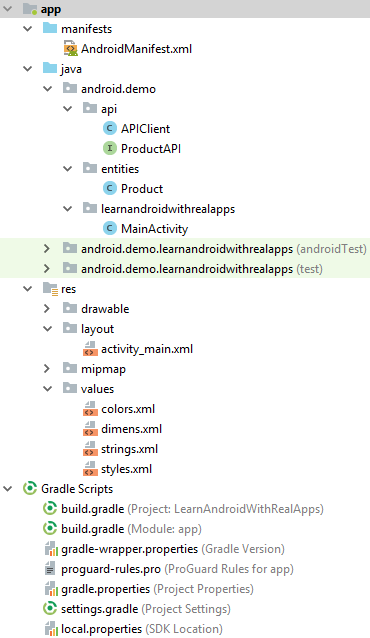
Run App
Load Main Activity
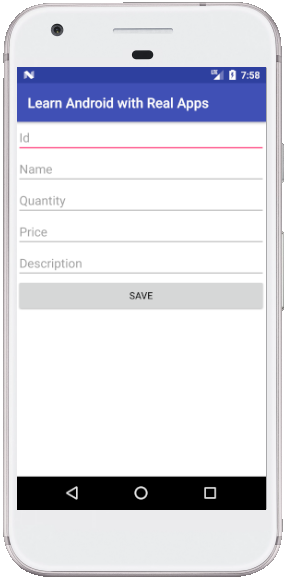
Input Product Information Need Update
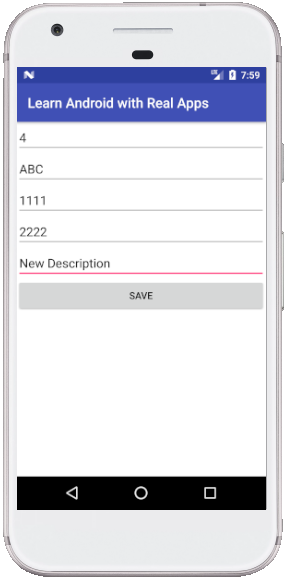
Display Message After Update Product
